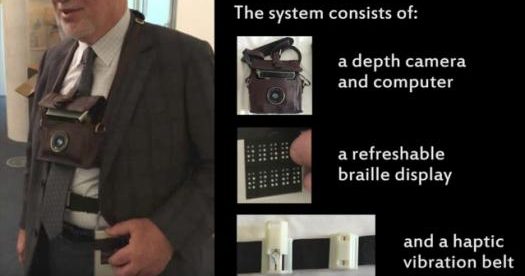MIT Researchers’ Prototype Wearable System Helps Blind People Navigate
Over the last three years or so, there have been several technological innovations geared towards helping blind people navigate, and continued innovation in that space is keeping things exciting.
Recently, a team of researchers from MIT came up with a prototype wearable system that helps blind people navigate their immediate surrounding and detect obstacles. The wearable system consists of a 3-D depth sensing camera and computer that is hung around the neck, a belt with haptic feedback, and a refreshable braille display that’s attached to the belt and shows the first letter of identified objects.
As a person is navigating their surrounding, the camera identifies objects around them and the computer attached to it runs an algorithm developed by the researchers that quickly identifies surfaces and their orientation from the 3-D camera’s data. As the blind person approaches an object, and is within 2 meters of it, the belt starts vibrating, telling the person that something is in their way. Identified objects like chair and tables are also communicated to the person. For example, for chairs, a “c” is displayed in the refreshable braille display. Similarly, an identified table is displayed as a “t”. The Braille display consists of 2 rows of 5 Braille pads. The letter’s position on the display indicates the direction in which the identified object can be found, and the column it appears in indicates the distance between the person and the object.
This wearable system could be used with or without a cane, although the tests the researchers did suggest that this system is more effective when used with a cane. As for the belt with the haptic feedback, the team tried several other methods for providing feedback – audio, vibrations on the neck, or something around the head – all these mediums were rejected by blind test users. Eventually, the belt was accepted, because it didn’t interfere with their other senses.
In the video below, a blind user can be seen locating a chair and bench, walk through a maze, and avoid a construction barrier. Although this wearable is still a prototype, the team is working on another version for outdoors with a larger library of objects the system could identify.
More readings on this topic:
Seeing AI: Microsoft project for blind people that let’s them “see”
Horus: A wearable “personal assistant” for blind people
Sunu Band: Wearable bracelet for visually impaired people
Sentiri: Headband to help blind people navigate
Brainport: Technology that lets blind people see with their tongue


Leave a comment